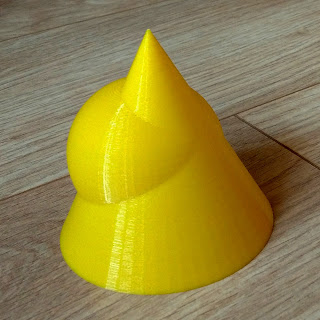Henger és kúp áthatása gömbbel
Ezekkel a modellekkel felfedezhető, hogy hogyan keletkezik egy henger vagy kúp gömbbel vett áthatása.
A henger gömbbel való áthatását egy modellsorozat szemlélteti. A kék színű gömbökben hengeres furatok láthatók:
- Ha a furat pontosan középen van, akkor az áthatás vonala két körből áll.
- Ha a furat nem pontosan középen halad, akkor az áthatás vonala két zárt ívből áll.
- Ha a furat meg tudja érinteni a gömböt, akkor az áthatás vonala egy 8-as formára emlékeztet, melyet a kék modellen a gumigyűrűvel ki lehet jobban emelni.
- Ha a furat még tovább mozdul a gömb középpontjához képest, akkor az áthatás vonala egyetlen zárt ívből áll. Lehet úgy forgatni a modellt, hogy a vonal babapiskótára emlékeztet.
A henger visszailleszthető a furatba, így a két forma egyesítése és különbsége is látható.
Kérdések, megfigyelések:
- Van olyan helyzet a fenti modellek esetén, ahol a metszet síkgörbe (vagy síkgörbékből áll)?
Vegye ki a hengert a furatokból és próbálja meg az asztallapra helyezni az áthatás vonalát! Ha a metszet stabilan felfekszik az asztalra, akkor síkgörbe. Ha billeg, akkor nem síkgörbe. - Milyen síkokra lesznek szimmetrikusak az áthatási görbék?
Vegye észre, hogy a gömbökön észrevehető ragasztási vonal (főkör) síkja minden esetben szimmetriasíkot ad! Ez a sík merőleges a hengert forgástengelyére. Ezen kívül van még szimmetria sík? Ha igen, akkor hány ilyen van? - Figyelje meg a gömbön és a hengeren a nyomtatásból származó vonalakat! Vegye észre, hogy ezek mentén mindkét testből egyszerre tudnánk szeleteket vágni. Egy ilyen vágáskor a gömbi szelet és a henger szelet éppen az áthatás vonalán találkozik.
Ha a kúp és gömb közös forgástengellyel rendelkezik, akkor az áthatás vonala két körből áll. Mivel ezek különböző magasságban vannak, így a sugaruk is különböző. Ezeket a találkozásokat a színváltások emelik ki.
Abban az esetben, ha a gömb és kúp érintkező helyzetben van, az áthatás vonala egy 8-ast formáz. Ennek a görbének nincs vízszintes helyzetű szimmetriasíkja, a felső hurok sokkal kisebb, mint az alsó.
A modellt megfordítva a teljes áthatási vonal egyszerre válik láthatóvá: a nagyobb hurok mintha tartalmazná a másikat.Mintafeladatok:
- Hamarosan
Intersection of cylinders and cones with sphere
These models help to discover how the intersection of a cylinder or cone with a sphere is created.
The intersection of the cylinder with the sphere is illustrated by a series of models in which the cylinder can be fitted back into the hole.
- If the hole is exactly in the middle, the curve of intersection consists of two circles.
- If the hole is not exactly in the middle, the curve of intersection consists of two closed arcs.
- If the hole and the sphere are tangent each other, the curve of intersection forms a shape 8 which can be highlighted better with a rubber ring on the blue model.
- If the hole moves even further relative to the center of the sphere, the curve of intersection consists of a single closed arc. You can rotate the model so that the line resembles a baby sponge cake.
The cylinder can be fitted back into the hole, so the union and difference of the shapes can also be illustrated.
Questions and comments:
- Is there a situation in the case of the above models where the section is a planar curve (or consists of planar curves)?
Take the cylinder out of the holes and try to place the curve on the tabletop. If the section rests firmly on the table, it is a planar curve. If it waggles, it is not a planar curve. - Try to describe the planes of symmetricity of curves of intersection.
Note that the plane of the gluing on the spheres (main circle) always gives a plane of symmetry! This plane is perpendicular to the axis of rotation of the cylinder. Are there other planes of symmetry? If so, how many are there? - Notice the horizontal threads which come from 3D printing process on the sphere and cylinder. Notice that along these lines we could cut slices from both shapes at the same time. In such a cut, spherical and cylindrical slices meet exactly on the line of influence.
If the spehe and the cone has common axis of roration, the curve of intersection consists of two circles. Since they are at different heights, their radii are also different. These encounters are highlighted by color changes.
If the sphere and cone tangent each other, the curve of intersection forms a figure 8. This curve has no horizontal plane of symmetry, the upper loop is much smaller than the lower one.
Holding the model upside down, the entire curve of intersection becomes visible at once: the larger loop seems to contain the other.Recommended worksheets:
- In progress





Nincsenek megjegyzések:
Megjegyzés küldése